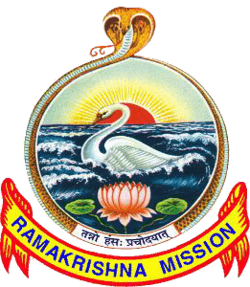Ramakrishna Mission Sevashrama
Ramakrishna Mission Sevashrama is a branch of Ramakrishna Math and Ramakrishna Mission involved in providing humanitarian, healthcare, education and relief services to poor and needy through the universal principle of serving "God in man", based on the motto, Atmano Moksartham Jagat Hitaya Cha, which was propounded by Swami Vivekananda.[1]
 | |
| Motto | Atmano mokshartham jagat hitaya cha (आत्मनो मोक्षार्थं जगद्धिताय च) (For one’s own salvation and for the welfare of the world) |
|---|---|
| Type | Religious organisation |
| Headquarters | India |
| Coordinates | 27.572055°N 77.694214°E |
| Affiliations | Neo-Vedanta |
List of Sevashramas
The oldest Sevashramas were Ramakrishna Mission Home of Service, in Varanasi, established by Kedarnath Moullik (Swami Achalananda) and Charu Chandra Das (Swami Subhananda), the two monastic disciples of Swami Vivekananda in 1900,[2] Ramakrishna Mission Sevashrama, Kankhal, established by Swami Kalyanananda and Swami Nischayananda, the two monastic disciples of Swami Vivekananda in 1901,[3] Ramakrishna Mission Sevashram in Vrindavan, established under Babu Jajneswar Chunder with his own son and Bramachari Harendra Nath of Belur Math in 1907,[4] Ramakrishna Mission Sevashrama Allahabad, established by Swami Vijnanananda in 1910.[5]

Subsequently other centers were established in different places which include - Ramakrishna Mission Sevashrama Silchar in Assam,
- Ramakrishna Mission Sevashrama Muzaffarpur, Bihar,
- Ramakrishna Mission T.B Sanatorium Ranchi,
- Ramakrishna Mission Sevashrama Calicut,
- Ramakrishna Mission Sevashrama Lukhnow,
- Ramakrishna Mission Sevashrama Bankura,
- Ramakrishna Mission Sevashrama Contai,
- Ramakrishna Mission Sevashrama Garbeta,
- Ramakrishna Mission Sarada Sevashrama Jayrambati,
- Ramakrishna Mission Seva Pratishthan in Kolkata, and
- Ramakrishna Mission Sevashrama Tamluk.[6]
Centers in Bangladesh include Dhaka (founded in 1899), Barisal (1904), Narayanganj (1909), Baliati at Manikganj (1910), Sylhet (1916), Chittagong (1921), Faridpur (1921), Habiganj (1921), Mymensingh (1922), Dinajpur (1923), Bagerhat (1926), and Comilla (1936).[7][8][9]
Work undertaken
The primary work undertaken by all Sevashramas is in the area of providing basic and advanced healthcare facilities to poor and needy at affordable costs, through the hospitals under their wings. All sevashramas work as their key principle service to the mankind irrespective of religion, caste and creed, in line with the philosophy of Vedanta of looking upon every human being as the manifestation of the divine as propounded by Sri Ramakrishna and Swami Vivekananda.[10] In addition some Sevashramas also offer educational, humanitarian (like relief and rehabilitation) and spiritual services.
References
- Ramakrishna Mission Sevashrama Archived 2014-02-23 at the Wayback Machine
- Varanasi Home of Service
- Kankhal Sevashrama
- First General Report of Ramakrishna Mission, 1912, by Swami Saradananda, Belur Math
- Allahabad Sevashrama
- List of branches of Ramakrishna Mission Sevashrama
- Swami Aksharananda (2012). "Ramakrishna Mission, Bangladesh". In Islam, Sirajul; Jamal, Ahmed A. (eds.). Banglapedia: National Encyclopedia of Bangladesh (Second ed.). Asiatic Society of Bangladesh.
- "Address and Activities of Chittagong Centre". Ramakrishna Math and Ramakrishna Mission. Retrieved 3 October 2015.
- "Address and Activities of Comilla Centre". Ramakrishna Math and Ramakrishna Mission. Retrieved 3 October 2015.
- Activities of Ramakrishna Mission Ashrama
